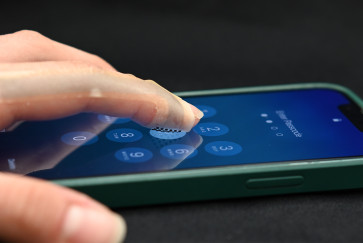Northwestern University engineers have developed a pacemaker so tiny that it can fit inside the tip of a syringe — and be non-invasively injected into the body.
Although it can work with hearts of all sizes, the pacemaker is particularly well-suited to the tiny, fragile hearts of newborn babies with congenital heart defects.
Smaller than a single grain of rice, the pacemaker is paired with a small, soft, flexible, wireless, wearable device that mounts onto a patient’s chest to control pacing. When the wearable device detects an irregular heartbeat, it automatically shines a light pulse to activate the pacemaker. These short pulses— which penetrate through the patient’s skin, breastbone and muscles — control the pacing.
Designed for patients who only need temporary pacing, the pacemaker simply dissolves after it’s no longer needed. All the pacemaker’s components are biocompatible, so they naturally dissolve into the body’s biofluids, bypassing the need for surgical extraction.
The study, published in the journal Nature, demonstrates the device’s efficacy across a series of large and small animal models as well as human hearts from deceased organ donors.
“We have developed what is, to our knowledge, the world’s smallest pacemaker,” said Northwestern bioelectronics pioneer John A. Rogers, who led the device development. “There’s a crucial need for temporary pacemakers in the context of pediatric heart surgeries, and that’s a use case where size miniaturization is incredibly important. In terms of the device load on the body — the smaller, the better.”
“Our major motivation was children,” said Northwestern experimental cardiologist Igor Efimov, who co-led the study. “About 1% of children are born with congenital heart defects — regardless of whether they live in a low-resource or high-resource country. The good news is that these children only need temporary pacing after a surgery. In about seven days or so, most patients’ hearts will self-repair. But those seven days are absolutely critical. Now, we can place this tiny pacemaker on a child’s heart and stimulate it with a soft, gentle, wearable device. And no additional surgery is necessary to remove it.”
Meeting an unmet clinical need
This work builds on a previous collaboration between Rogers and Efimov, in which they developed the first dissolvable device for temporary pacing. Many patients require temporary pacemakers after heart surgery — either while waiting for a permanent pacemaker or to help restore a normal heart rate during recovery.
For the current standard of care, surgeons sew the electrodes onto the heart muscle during surgery. Wires from the electrodes exit the front of a patient’s chest, where they connect to an external pacing box that delivers a current to control the heart’s rhythm.
When the temporary pacemaker is no longer needed, physicians remove the pacemaker electrodes. Potential complications include infection, dislodgement, torn or damaged tissues, bleeding and blood clots.
“Wires literally protrude from the body, attached to a pacemaker outside the body,” Efimov said. “When the pacemaker is no longer needed, a physician pulls it out. The wires can become enveloped in scar tissue. So, when the wires are pulled out, that can potentially damage the heart muscle. That’s actually how Neil Armstrong died. He had a temporary pacemaker after a bypass surgery. When the wires were removed, he experienced internal bleeding.”
In response to this clinical need, Rogers, Efimov and their teams developed their dissolvable pacemaker, which was introduced in Nature Biotechnology in 2021. The thin, flexible, lightweight device eliminated the need for bulky batteries and rigid hardware, including wires. Rogers’ lab had previously invented the concept of bioresorbable electronic medicine — electronics that provide a therapeutic benefit to the patient and then harmlessly dissolve in the body like absorbable sutures. By varying the composition and thickness of the materials in these devices, Rogers’ team can control the precise number of days they remain functional before dissolving.
Body fluid-powered battery
While the original quarter-size dissolvable pacemaker worked well in pre-clinical animal studies, cardiac surgeons asked if it was possible to make the device smaller. Then it would be better suited to non-invasive implantation and for use in the smallest patients. But the device was powered by near-field communication protocols — the same technology used in smartphones for electronic payments and in RFID tags — which required a built-in antenna.
“Our original pacemaker worked well,” Rogers said. “It was thin, flexible and fully resorbable. But the size of its receiver antenna limited our ability to miniaturize it. Instead of using the radio frequency scheme for wireless control, we developed a light-based scheme for turning the pacemaker on and delivering stimulation pulses to the surface of the heart. This is one feature that allowed us to dramatically reduce the size.”


